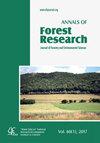Effects of two different thinning methods on the diameter and basal area increments of silver lime (Tilia tomentosa Moench) target trees in Fruška Gora (Serbia)
IF 1.7
3区 农林科学
Q2 FORESTRY
引用次数: 2
Abstract
This paper analyses the cumulative effects of selective thinning and thinning from below on diameter and basal area increments of target trees after 25/26 years in 52, 69- and 86-year-old silver lime (Tilia tomentosa Moench) stands. Two target tree collectives were analysed: (1) elite trees selected between 1993–1994 from permanent sampling plots (selective thinning method), and (2) a ‘comparable collective’ of target trees selected in 2019 (25/26 years later) according to the same criteria as the elite trees, in the same stands thinned from below. Elite trees that were selectively thinned had: higher diameter, basal area and volume per tree, higher diameter and basal area increment for a given time period, and lower slenderness coefficients compared to the target trees that were thinned from below at 52 and 69 yr. While diameter increment decreases with age, and differences between elite trees of different ages are clearly delineated, diameter increments of trees thinned from below are not significantly different at 52 and 69 yr. In addition, basal area increment of trees is highest at 69 yr with selective thinning. When thinning from below, there were no significant differences in basal area increments between trees at 69 and 86 yr. Silver lime shows a strong growth response after selective thinning at ages 25/26 and 44 yr. However, our results show that this response is less pronounced when selective thinning begins at 61 yr.两种不同间伐方法对Fruška Gora地区银石灰(tila tomentosa Moench)目标树直径和基面积增量的影响
本文分析了在52年、69年和86年生的银石灰(Tilia tomentosa Moench)林中,选择性疏伐和从下疏伐对25/26年后目标树直径和基部面积增量的累积影响。分析了两个目标树集体:(1)1993年至1994年间从永久采样点(选择性疏伐法)中选出的精英树,以及(2)2019年(25/26年后)根据与精英树相同的标准,在从下方疏伐的相同林分中选出的目标树的“可比集体”。与52年和69年时从下方疏伐的目标树相比,选择性疏伐的精英树具有:更高的直径、每棵树的基面积和体积,在给定时间段内更高的径和基面积增量,以及更低的长细比系数。虽然径增量随年龄而减小,不同年龄的精英树之间的差异清晰可见,从下方疏伐的树木在52年和69年时直径增量没有显著差异。此外,选择性疏伐的树基面积增量在69年时最高。从下方疏伐时,69年和86年时树木的基底面积增量没有显著差异。银石灰在25/26年和44年时选择性疏伐后表现出强烈的生长反应。然而,我们的结果表明,当61年时开始选择性疏伐时这种反应不太明显。
本文章由计算机程序翻译,如有差异,请以英文原文为准。
求助全文
约1分钟内获得全文
求助全文
来源期刊

Annals of Forest Research
FORESTRY-
CiteScore
2.20
自引率
11.10%
发文量
11
审稿时长
12 weeks
期刊介绍:
Annals of Forest Research is a semestrial open access journal, which publishes research articles, research notes and critical review papers, exclusively in English, on topics dealing with forestry and environmental sciences. The journal promotes high scientific level articles, by following international editorial conventions and by applying a peer-review selection process.
 求助内容:
求助内容: 应助结果提醒方式:
应助结果提醒方式:


